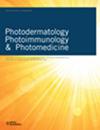Effect of education on sun‐safe behaviour in kidney transplant recipients
IF 2.2
4区 医学
Q2 DERMATOLOGY
引用次数: 0
Abstract
BackgroundOrgan transplant recipients (OTR) are more likely to develop skin cancer than the general population. One of the main components of the exposome that triggers the development of skin tumours is solar ultraviolet (UV) radiation. To reduce the incidence of harmful consequences of sun exposure, sun protection education is needed for patients taking long‐term immunosuppressive drugs.MethodsIn a previous study, we assessed the sun‐safe behaviour of 221 OTR using a questionnaire before and after transplantation and personally educated the patients about proper sun protection. After the education, there were no further reminder presentations. Presently, the sun protection and sun seeking habits of the available 176 of these patients were questioned to assess the long‐term effect of the previous sun protection education.ResultsTwo‐four years after the education, more patients wore hats and protected their skin with long‐sleeved clothing than before the education. In terms of sun seeking habits, both occupational and recreational sun exposure decreased significantly. Significantly fewer people went on holiday after transplantation, but those who went on holiday spent significantly less time in the sun.ConclusionThe long‐term positive effects of education can be seen both in the patients' sun protection and in their sun seeking habits. However, the long‐term goal is to maintain these results and thereby reduce the likelihood of skin tumours and consequently the associated tumour death.教育对肾移植受者防晒行为的影响
背景器官移植受者(OTR)比普通人更容易患皮肤癌。太阳紫外线(UV)辐射是诱发皮肤肿瘤的暴露体的主要成分之一。为了减少日光照射造成的有害后果,需要对长期服用免疫抑制剂的患者进行防晒教育。教育结束后,我们没有再对患者进行提醒。目前,我们对其中 176 名患者的防晒和寻求阳光的习惯进行了调查,以评估之前防晒教育的长期效果。从晒太阳的习惯来看,职业性和娱乐性晒太阳的情况都明显减少。移植后去度假的人数明显减少,但去度假的人在阳光下曝晒的时间也明显减少。然而,长期目标是保持这些效果,从而降低皮肤肿瘤的可能性,并减少相关的肿瘤死亡。
本文章由计算机程序翻译,如有差异,请以英文原文为准。
求助全文
约1分钟内获得全文
求助全文
来源期刊
CiteScore
4.40
自引率
7.70%
发文量
85
审稿时长
6-12 weeks
期刊介绍:
The journal is a forum for new information about the direct and distant effects of electromagnetic radiation (ultraviolet, visible and infrared) mediated through skin. The divisions of the editorial board reflect areas of specific interest: aging, carcinogenesis, immunology, instrumentation and optics, lasers, photodynamic therapy, photosensitivity, pigmentation and therapy. Photodermatology, Photoimmunology & Photomedicine includes original articles, reviews, communications and editorials.
Original articles may include the investigation of experimental or pathological processes in humans or animals in vivo or the investigation of radiation effects in cells or tissues in vitro. Methodology need have no limitation; rather, it should be appropriate to the question addressed.

 求助内容:
求助内容: 应助结果提醒方式:
应助结果提醒方式:


